Effect of Wood Densification and GFRP Reinforcement on the Embedment Strength of Poplar CLT
Abstract
:1. Introduction
2. Materials and Methods
2.1. Materials and CLT Fabrication
Embedment Strength Modelling and Experiments
2.2. Statistical Analysis
2.3. Embedment Strength Equations
3. Results and Discussion
Effect of Densification Ratio and Loading Direction on Embedment Strength
4. Conclusions
Author Contributions
Funding
Institutional Review Board Statement
Informed Consent Statement
Data Availability Statement
Conflicts of Interest
References
- Dong, W.; Li, Q.; Wang, Z.; Zhang, H.; Lu, X.; Gong, M. Effects of embedment side and loading direction on embedment strength of cross-laminated timber for smooth dowels. Eur. J. Wood Wood Prod. 2020, 78, 17–25. [Google Scholar] [CrossRef]
- Dong, W.; Wang, Z.; Zhou, J.; Zhang, H.; Yao, Y.; Zheng, W.; Gong, M.; Shi, X. Embedment strength of smooth dowel-type fasteners in cross-laminated timber. Constr. Build. Mater. 2020, 233, 117243. [Google Scholar] [CrossRef]
- Rashidi, M.; Hoshyar, A.N.; Smith, L.; Samali, B.; Siddique, R. A comprehensive taxonomy for structure and material deficiencies, preventions and remedies of timber bridges. J. Build. Eng. 2021, 34, 101624. [Google Scholar] [CrossRef]
- Bora, S.; Sinha, A.; Barbosa, A.R. Effect of Short-Term Simulated Rain Exposure on the Performance of Cross-Laminated Timber Angle Bracket Connections. J. Archit. Eng. 2022, 28, 04022025. [Google Scholar] [CrossRef]
- Ling, T.; Mohrmann, S.; Li, H.; Bao, N.; Gaff, M.; Lorenzo, R. Review on research progress of metal-plate-connected wood joints. J. Build. Eng. 2022, 105056. [Google Scholar] [CrossRef]
- Ringhofer, A.; Brandner, R.; Blaß, H.J. Cross laminated timber (CLT): Design approaches for dowel-type fasteners and connections. Eng. Struct. 2018, 171, 849–861. [Google Scholar] [CrossRef]
- Ling, Z.; Rong, X.; Xiang, Z. Laterally loaded performance of single dowel-type fastener used for steel plate-to-timber connections. In Structures; Elsevier: Amsterdam, The Netherlands, 2021; pp. 1985–1997. [Google Scholar]
- Sydor, M.; Rogoziński, T.; Stuper-Szablewska, K.M.; Starczewski, K. The accuracy of holes drilled in the side surface of plywood. BioResources 2020, 15, 117–129. [Google Scholar] [CrossRef]
- Sydor, M.; Majka, J.; Rychlik, M.; Turbański, W. Application of 3D Scanning Method to Assess Mounting Holes’ Shape Instability of Pinewood. Materials 2023, 16, 2053. [Google Scholar] [CrossRef]
- Yurrita, M.; Cabrero, J.M. New criteria for the determination of the parallel-to-grain embedment strength of wood. Constr. Build. Mater. 2018, 173, 238–250. [Google Scholar] [CrossRef]
- Jorissen, A.; Fragiacomo, M. General notes on ductility in timber structures. Eng. Struct. 2011, 33, 2987–2997. [Google Scholar] [CrossRef]
- Zhang, X.; Yin, H.; Zhao, E.; Li, S.; Liu, Q. Experimental investigation on embedment strength of bamboo-based composite prepared with the inorganic adhesive. J. Build. Eng. 2023, 76, 107323. [Google Scholar] [CrossRef]
- Blaß, H.J.; Uibel, T. Tragfähigkeit von Stiftförmigen Verbindungsmitteln in Brettsperrholz; Karlsruher Institut für Technologie: Karlsruhe, Germany, 2007. [Google Scholar]
- Uibel, T.; Blaß, H.J. Edge joints with dowel type fasteners in cross laminated timber. In Proceedings of the CIB-W18 Meeting, Bled, Slovenia, 8 August 2007. [Google Scholar]
- Uibel, T.; Blaß, H.J. Joints with dowel type fasteners in CLT structures. In Proceedings of the Focus Solid Timber Solutions-European Conference on Cross Laminated Timber (CLT), Bath, UK, 21–22 May 2013; pp. 119–136. [Google Scholar]
- HJ, B. Load-carrying capacity of joints with dowel-type fasteners and interlayers. In Proceedings of the CIB-W18, Delft, 2000, Florence, Italy, 16–19 August 2000. [Google Scholar]
- Santos, C.; De Jesus, A.; Morais, J.; Lousada, J. A comparison between the EN 383 and ASTM D5764 test methods for dowel-bearing strength assessment of wood: Experimental and numerical investigations. Strain 2010, 46, 159–174. [Google Scholar] [CrossRef]
- Kim, K. Predicting Nail Withdrawal Resistance and Bearing Strength of Cross-laminated Timbers from Mixed Species. BioResources 2021, 16, 4027–4038. [Google Scholar] [CrossRef]
- Ottenhaus, L.-M.; Li, M.; Smith, T. Analytical derivation and experimental verification of overstrength factors of dowel-type timber connections for capacity design. J. Earthq. Eng. 2022, 26, 2970–2984. [Google Scholar] [CrossRef]
- Ou, J.; Yang, X.; Xu, Q. Experimental research on the embedment strength of cross-laminated timber. Sichuan Build. Sci. 2020, 46, 28–35. [Google Scholar]
- Hongyuan, T.; Menglin, M.; Yuan, Y.; Ruizhong, L.; Zhaoyang, Y. Experimental study on dowel bearing strength of cross-laminated-timber (CLT) panels. J. Build. Struct. 2022, 43, 175. [Google Scholar]
- Sandhaas, C.; Ravenshorst, G.; Blass, H.; Van de Kuilen, J. Embedment tests parallel-to-grain and ductility aspects using various wood species. Eur. J. Wood Wood Prod. 2013, 71, 599–608. [Google Scholar] [CrossRef]
- Abdoli, F.; Rashidi, M.; Rostampour-Haftkhani, A.; Layeghi, M.; Ebrahimi, G. Withdrawal performance of nails and screws in cross-laminated timber (CLT) made of Poplar (Populus alba) and Fir (Abies alba). Polymers 2022, 14, 3129. [Google Scholar] [CrossRef]
- Abdoli, F.; Rashidi, M.; Rostampour-Haftkhani, A.; Layeghi, M.; Ebrahimi, G. Effects of fastener type, end distance, layer arrangement, and panel strength direction on lateral resistance of single shear lap joints in cross-laminated timber (CLT). Case Stud. Constr. Mater. 2023, 18, e01727. [Google Scholar] [CrossRef]
- Rostampour Haftkhani, A.; Rashidi, M.; Abdoli, F.; Gerami, M. The effect of GFRP wrapping on lateral performance of double shear lap joints in cross-laminated timber as a part of timber bridges. Buildings 2022, 12, 1678. [Google Scholar] [CrossRef]
- Kramer, A.; Barbosa, A.R.; Sinha, A. Viability of hybrid poplar in ANSI approved cross-laminated timber applications. J. Mater. Civ. Eng. 2014, 26, 06014009. [Google Scholar] [CrossRef]
- Wang, Z.; Fu, H.; Chui, Y.-H.; Gong, M. Feasibility of using poplar as cross layer to fabricate cross-laminated timber. In Proceedings of the World Conference on Timber Engineering, Quebec City, QC, Canada, 10–14 August 2014. [Google Scholar]
- Hematabadi, H.; Madhoushi, M.; Khazaeian, A.; Ebrahimi, G. Structural performance of hybrid Poplar-Beech cross-laminated-timber (CLT). J. Build. Eng. 2021, 44, 102959. [Google Scholar] [CrossRef]
- Hematabadi, H.; Madhoushi, M.; Khazaeyan, A.; Ebrahimi, G.; Hindman, D.; Loferski, J. Bending and shear properties of cross-laminated timber panels made of poplar (Populus alba). Constr. Build. Mater. 2020, 265, 120326. [Google Scholar] [CrossRef]
- Lukaszewska, E.; Fragiacomo, M.; Johnsson, H. Laboratory tests and numerical analyses of prefabricated timber-concrete composite floors. J. Struct. Eng. 2010, 136, 46–55. [Google Scholar] [CrossRef]
- Saribiyik, M.; Akgül, T. GFRP bar element to strengthen timber connection systems. Sci. Res. Essays 2010, 5, 1713–1719. [Google Scholar]
- Miotto, J.L.; Dias, A.A. Evaluation of perforated steel plates as connection in glulam–concrete composite structures. Constr. Build. Mater. 2012, 28, 216–223. [Google Scholar] [CrossRef]
- Nie, Y.; Valipour, H. Experimental and numerical study of long-term behaviour of timber-timber composite (TTC) connections. Constr. Build. Mater. 2021, 304, 124672. [Google Scholar] [CrossRef]
- Clouston, P.; Bathon, L.A.; Schreyer, A. Shear and bending performance of a novel wood–concrete composite system. J. Struct. Eng. 2005, 131, 1404–1412. [Google Scholar] [CrossRef]
- Otero-Chans, D.; Estévez-Cimadevila, J.; Suárez-Riestra, F.; Martín-Gutiérrez, E. Experimental analysis of glued-in steel plates used as shear connectors in Timber-Concrete-Composites. Eng. Struct. 2018, 170, 1–10. [Google Scholar] [CrossRef]
- Chybiński, M.; Polus, Ł. Mechanical behaviour of aluminium-timber composite connections with screws and toothed plates. Materials 2021, 15, 68. [Google Scholar] [CrossRef]
- Raftery, G.M.; Whelan, C. Low-grade glued laminated timber beams reinforced using improved arrangements of bonded-in GFRP rods. Constr. Build. Mater. 2014, 52, 209–220. [Google Scholar] [CrossRef]
- Gómez, S.; Svecova, D. Behavior of split timber stringers reinforced with external GFRP sheets. J. Compos. Constr. 2008, 12, 202–211. [Google Scholar] [CrossRef]
- Hay, S.; Thiessen, K.; Svecova, D.; Bakht, B. Effectiveness of GFRP sheets for shear strengthening of timber. J. Compos. Constr. 2006, 10, 483–491. [Google Scholar] [CrossRef]
- Wu, C.; Zhang, Z.; Tam, L.-h.; Feng, P.; He, L. Group effect of GFRP-timber bolted connections in tension. Compos. Struct. 2021, 262, 113637. [Google Scholar] [CrossRef]
- Cabral, J.P.; Kafle, B.; Subhani, M.; Reiner, J.; Ashraf, M. Densification of timber: A review on the process, material properties, and application. J. Wood Sci. 2022, 68, 20. [Google Scholar] [CrossRef]
- Feng, T.Y.; Chiang, L.K. Effects of densification on low-density plantation species for cross-laminated timber. In Proceedings of the AIP Conference Proceedings, Kuala Lumpur, Malaysia, 26–28 August 2019. [Google Scholar]
- Salca, E.-A.; Bekhta, P.; Seblii, Y. The effect of veneer densification temperature and wood species on the plywood properties made from alternate layers of densified and non-densified veneers. Forests 2020, 11, 700. [Google Scholar] [CrossRef]
- Kennedy, S.; Salenikovich, A.; Munoz, W.; Mohammad, M. Design equations for dowel embedment strength and withdrawal resistance for threaded fasteners in CLT. In Proceedings of the World Conference on Timber Engineering, Quebec, QC, Canada, 10–14 August 2014; pp. 10–14. [Google Scholar]
- National Design Specification (NDS). National Design Specification (NDS) for Wood Construction–with Commentary, 2015th ed.; American Wood Council: Leesburg, VA, USA, 2014. [Google Scholar]
- Uibel, T.; Blaß, H.J. Load carrying capacity of joints with dowel type fasteners in solid wood panels. In Proceedings of the CIB-W18 Meeting, Bled, Slovenia, 8 August 2007. [Google Scholar]
- CSA. O86-14; Engineering Design in Wood. Canadian Standards Association: Mississauga, ON, Canada, 2014.
- Long, W.; Ou, J.; Sun, X.; Huang, X.; He, M.; Li, Z. Experimental study on the embedment strength of smooth dowels inserted in cross-laminated timber narrow side. J. Wood Sci. 2022, 68, 1–18. [Google Scholar] [CrossRef]
- Tuhkanen, E.; Mölder, J.; Schickhofer, G. Influence of number of layers on embedment strength of dowel-type connections for glulam and cross-laminated timber. Eng. Struct. 2018, 176, 361–368. [Google Scholar] [CrossRef]
- Sawata, K.; Yasumura, M. Determination of embedding strength of wood for dowel-type fasteners. J. Wood Sci. 2002, 48, 138–146. [Google Scholar] [CrossRef]
- Lewis, C.D. Industrial And Business Forecasting Methods: A Practical Guide to Exponential Smoothing and Curve Fitting; Butterworth Scientific: Oxford, UK, 1982. [Google Scholar]
- Nasir, V.; Ayanleye, S.; Kazemirad, S.; Sassani, F.; Adamopoulos, S. Acoustic emission monitoring of wood materials and timber structures: A critical review. Constr. Build. Mater. 2022, 350, 128877. [Google Scholar] [CrossRef]
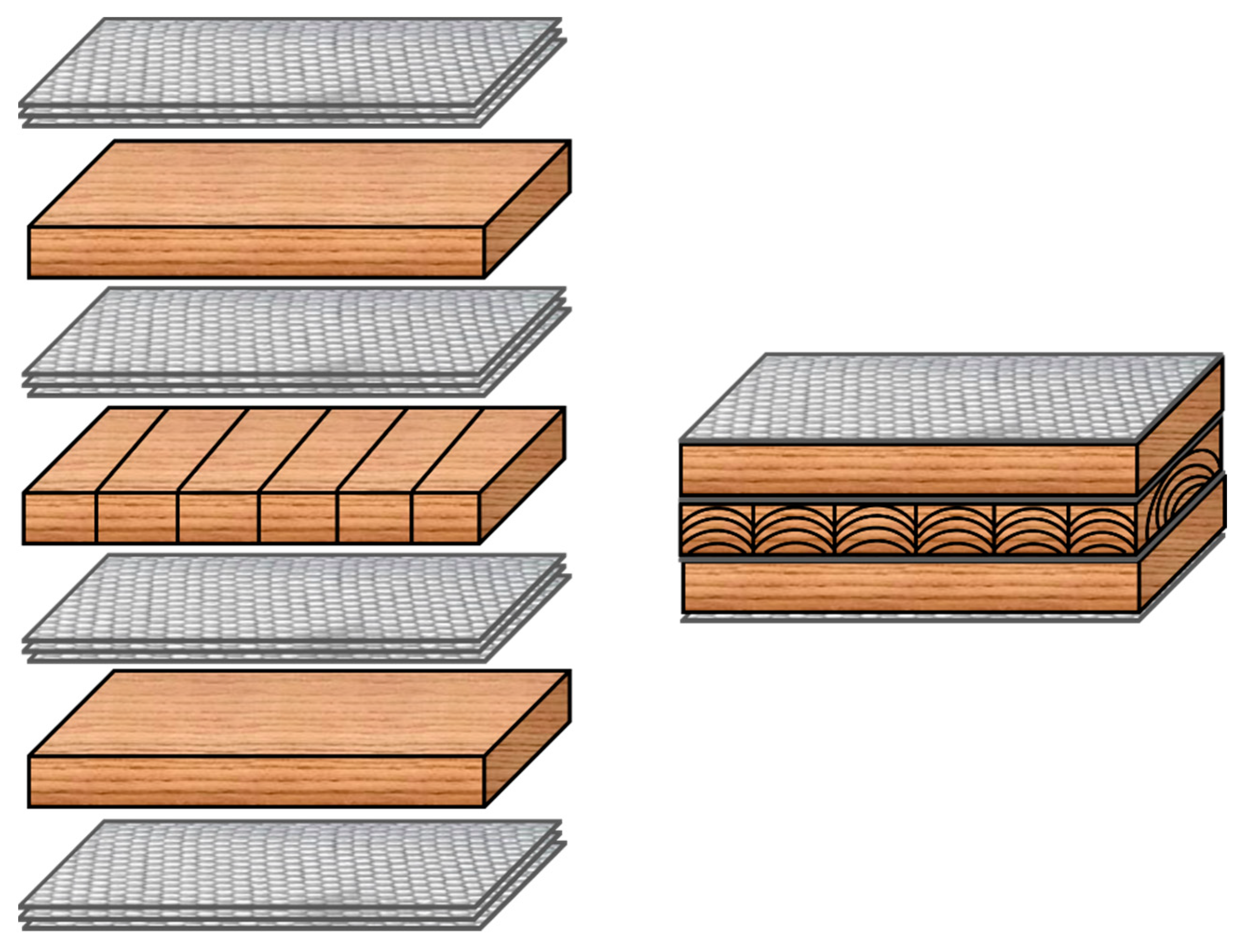

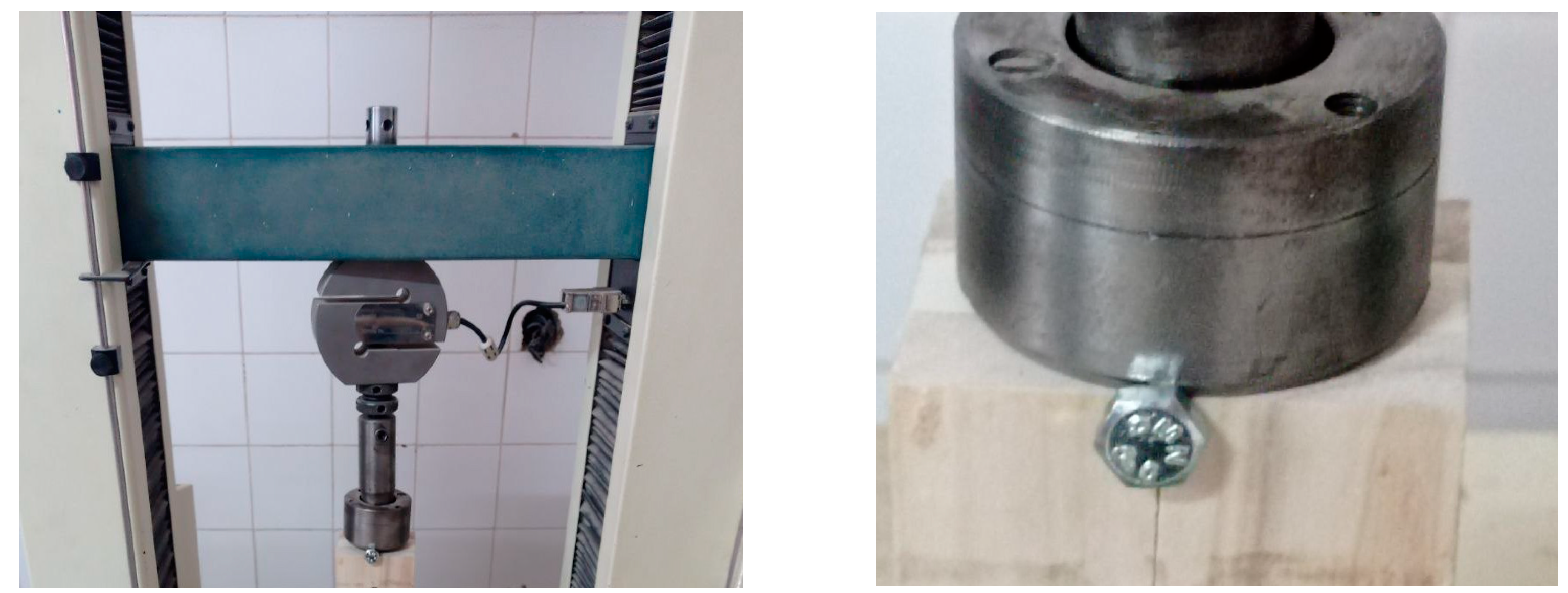
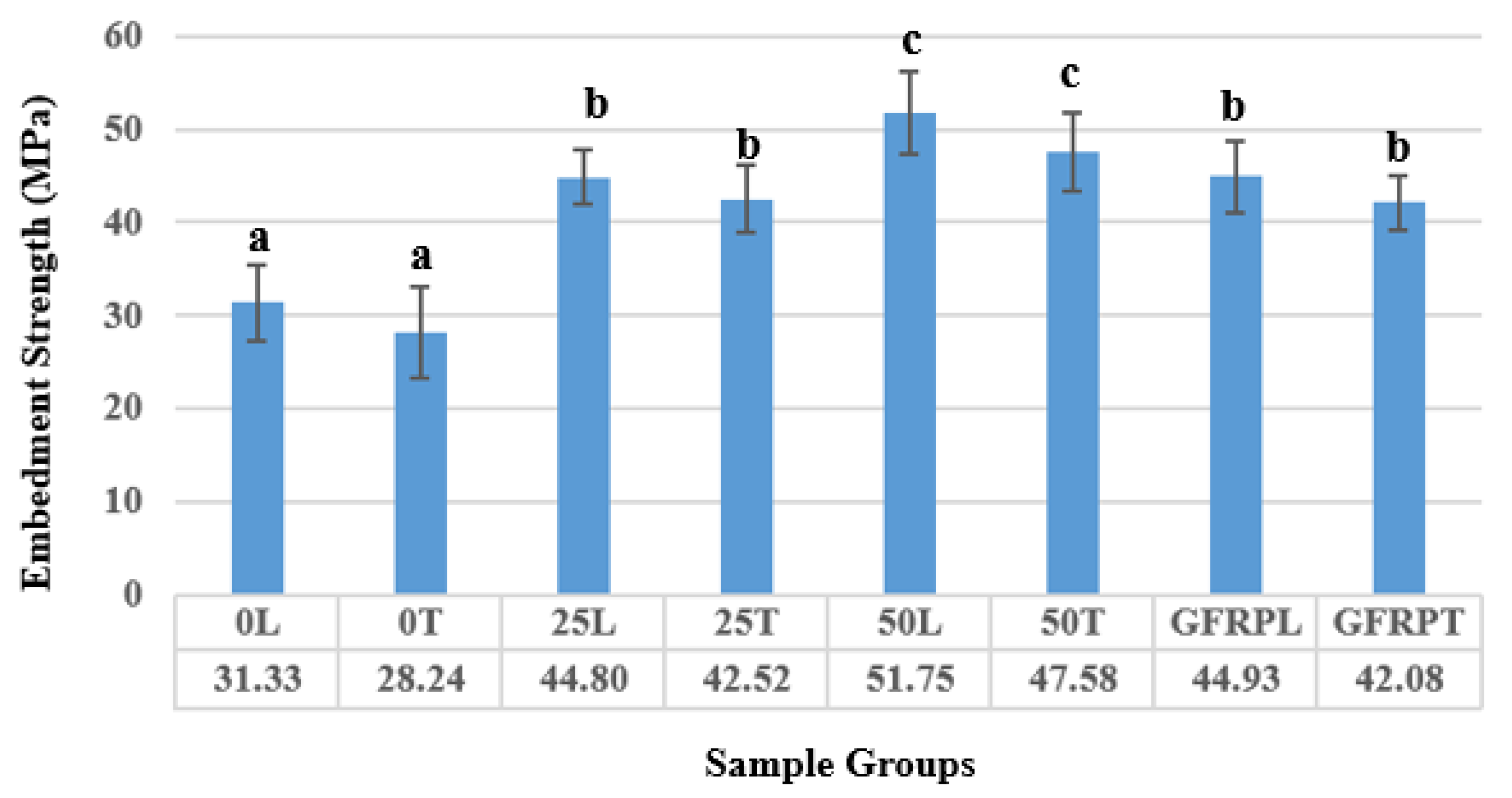
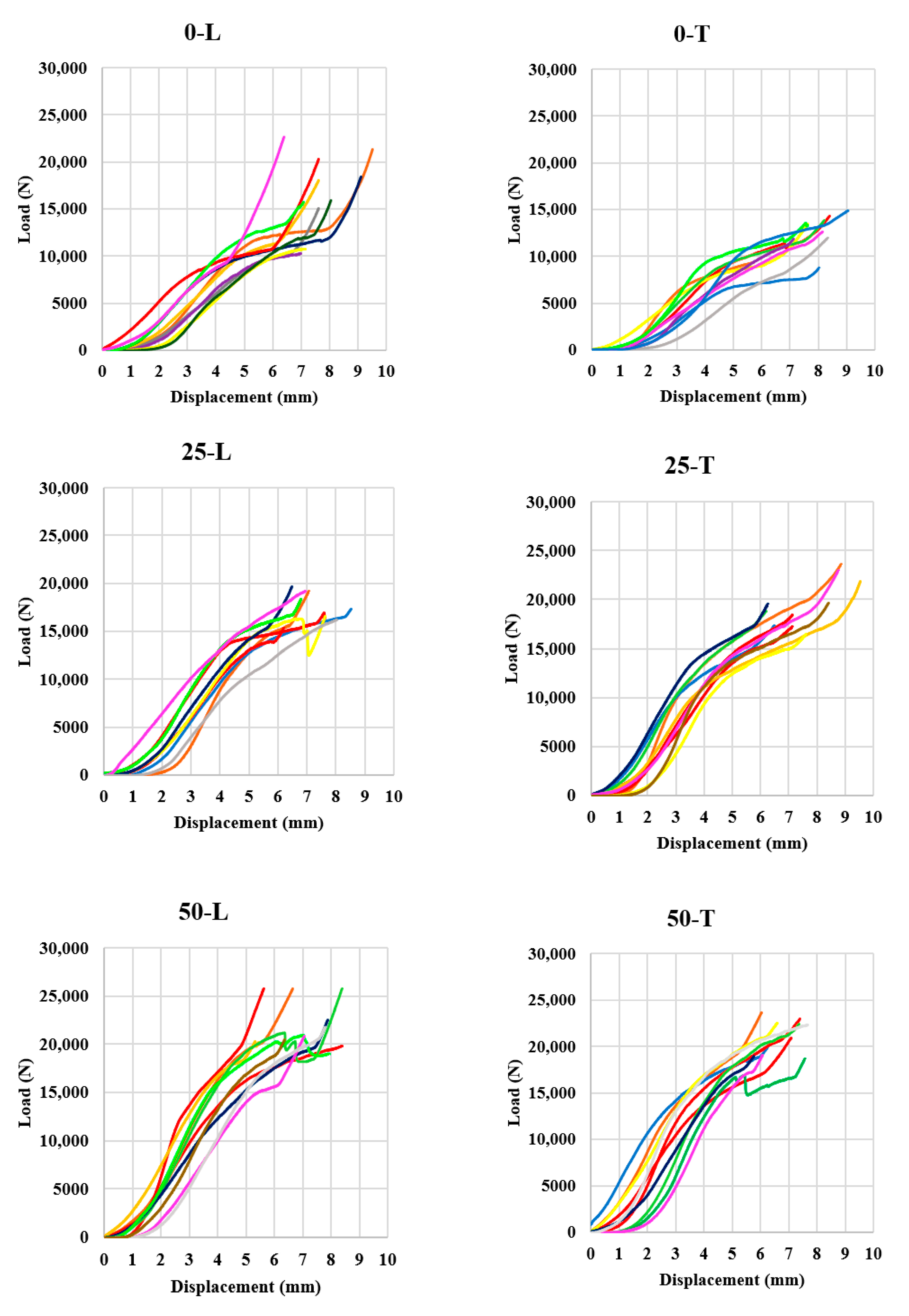
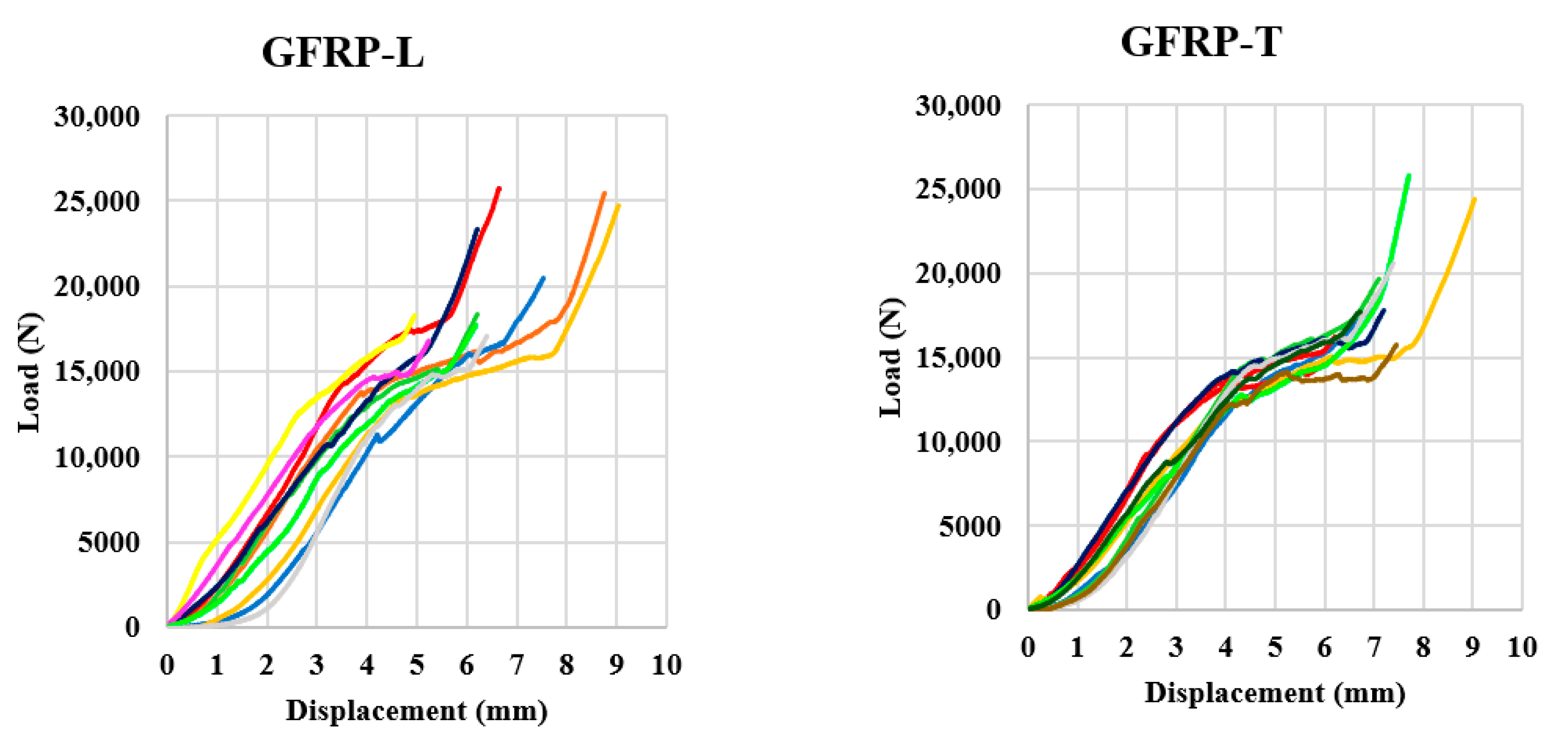

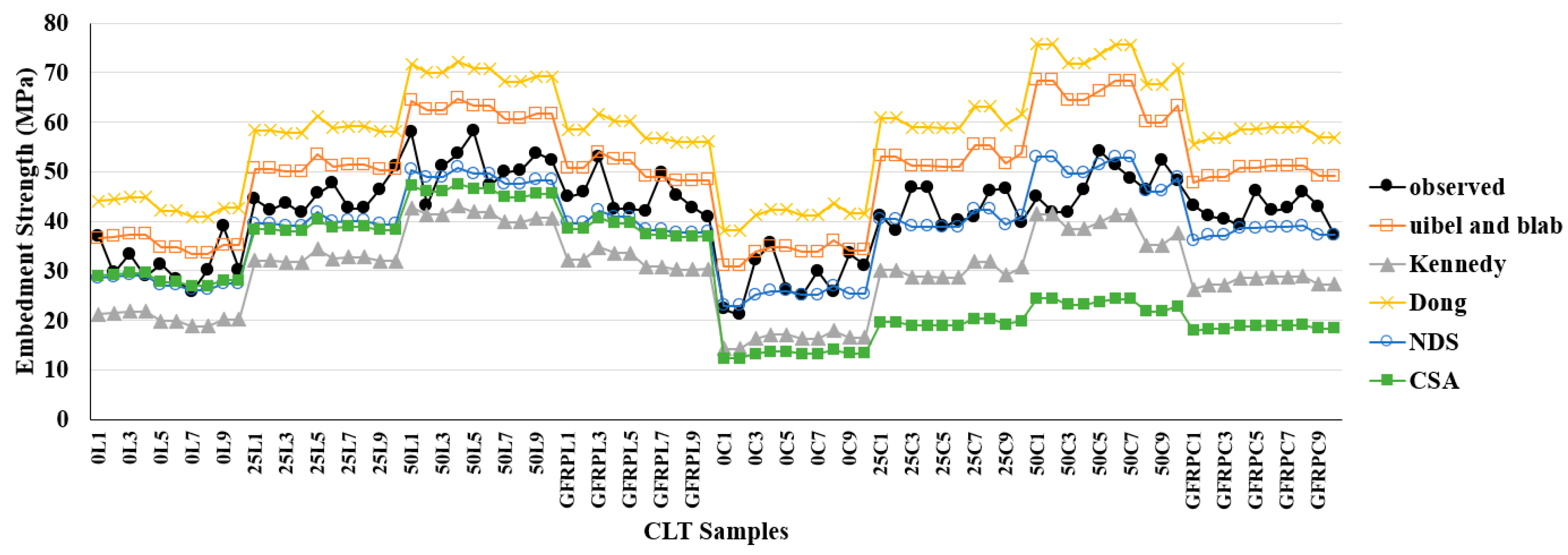
| Sample Groups | Repetitions | Description |
|---|---|---|
| Control (unreinforced) | 10 | No reinforcement |
| 0L, 0T | (Loading direction: L = longitudinal, T = transverse) | |
| 25L | 10 | Reinforcement with 25% densification (loading direction: longitudinal) |
| 25T | 10 | Reinforcement with 25% densification (loading direction: transverse) |
| 50L | 10 | Reinforcement with 50% densification (loading direction: longitudinal) |
| 50T | 10 | Reinforcement with 50% densification (loading direction: transverse) |
| GFRPL | 10 | Reinforcement with GFRP (loading direction: longitudinal) |
| GFRPT | 10 | Reinforcement with GFRP (loading direction: transverse) |
| Lag Screw (DIN 571) | Length of the Screw (L) (mm) | Head Height (K) (mm) | Da (mm) | Ds (mm) | Length of the Thread (b) (mm) |
|---|---|---|---|---|---|
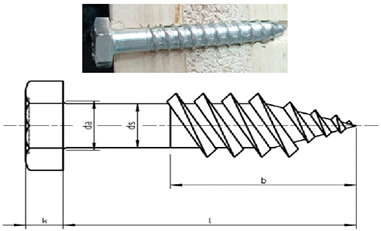 | 54 | 5.5 | 8.5 | 7 | 44 |
| Property | Source | df | Mean Square | F | Sig. |
|---|---|---|---|---|---|
| Embedment strength | Densification ratio | 2 | 2079.221 | 124.640 | 0.000 ** |
| Loading direction | 1 | 151.877 | 9.104 | 0.004 ** | |
| Densification ratio × loading direction | 2 | 4.520 | 0.271 | 0.764 ns |
| Main Effects | |||
|---|---|---|---|
| Densification ratio | 0 | 29.8 (4.65) * | A ** |
| 25 | 43.7 (3.4) | B | |
| 50 | 49.7 (4.76) | C | |
| Loading direction | T | 39.44 (9.29) | A |
| L | 42.62 (9.41) | B | |
| Interaction effects | |||
| Densification ratio | Loading direction | Embedment strength (MPa) | |
| 0 | T | 28.24 (4.88) | A |
| L | 31.33 (4.07) | A | |
| 25 | T | 42.52 (3.61) | B |
| L | 44.8 (2.92) | BC | |
| 50 | T | 47.58 (4.19) | C |
| L | 51.75 (4.54) | D | |
| MAPE (%) | ||||
|---|---|---|---|---|
| Ubel and Blab | Kennedy | Dong et al. | NDS | CSA |
| 21.30 | 28.86 | 40.07 | 10.31 | 32.68 |
Disclaimer/Publisher’s Note: The statements, opinions and data contained in all publications are solely those of the individual author(s) and contributor(s) and not of MDPI and/or the editor(s). MDPI and/or the editor(s) disclaim responsibility for any injury to people or property resulting from any ideas, methods, instructions or products referred to in the content. |
© 2023 by the authors. Licensee MDPI, Basel, Switzerland. This article is an open access article distributed under the terms and conditions of the Creative Commons Attribution (CC BY) license (https://creativecommons.org/licenses/by/4.0/).
Share and Cite
Rostampour-Haftkhani, A.; Abdoli, F.; Arabi, M.; Nasir, V.; Rashidi, M. Effect of Wood Densification and GFRP Reinforcement on the Embedment Strength of Poplar CLT. Appl. Sci. 2023, 13, 12249. https://doi.org/10.3390/app132212249
Rostampour-Haftkhani A, Abdoli F, Arabi M, Nasir V, Rashidi M. Effect of Wood Densification and GFRP Reinforcement on the Embedment Strength of Poplar CLT. Applied Sciences. 2023; 13(22):12249. https://doi.org/10.3390/app132212249
Chicago/Turabian StyleRostampour-Haftkhani, Akbar, Farshid Abdoli, Mohammad Arabi, Vahid Nasir, and Maria Rashidi. 2023. "Effect of Wood Densification and GFRP Reinforcement on the Embedment Strength of Poplar CLT" Applied Sciences 13, no. 22: 12249. https://doi.org/10.3390/app132212249
APA StyleRostampour-Haftkhani, A., Abdoli, F., Arabi, M., Nasir, V., & Rashidi, M. (2023). Effect of Wood Densification and GFRP Reinforcement on the Embedment Strength of Poplar CLT. Applied Sciences, 13(22), 12249. https://doi.org/10.3390/app132212249











